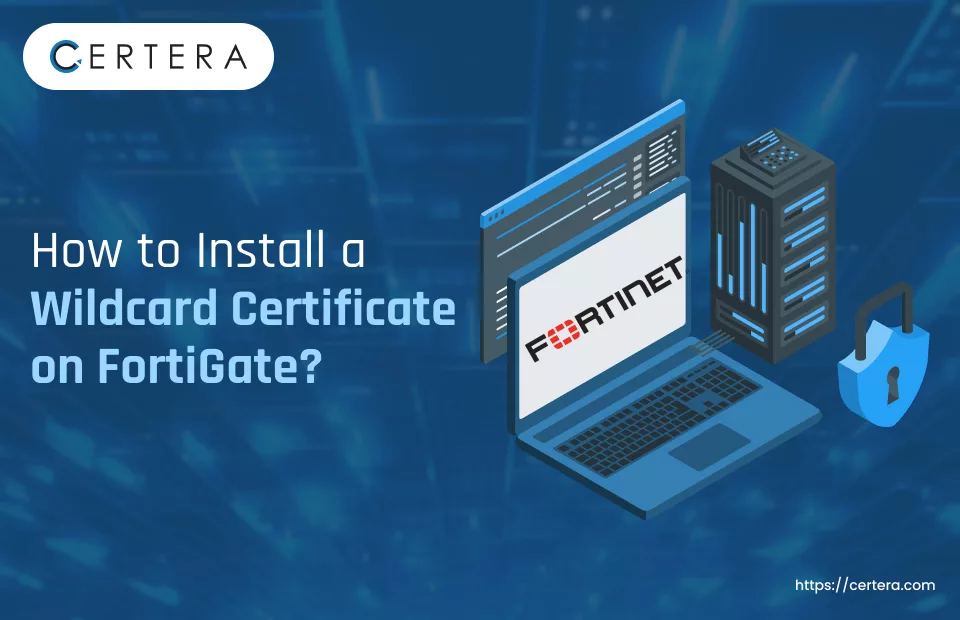How to Install a Wildcard Certificate on FortiGate?

Introduction
As the internet becomes even more ingrained in day-to-day activities, specifically business ones, Web security is a crucial factor for most organizations. As the number of subdomains and web apps rises, keeping track of individual SSL/TLS certificates may be challenging.
This is where wildcard SSL certificates can be useful, as it would mean that you are effectively purchasing protection for as many subdomains under the main domain as needed at a relatively low cost. Network security is one of the major key features organizations consider in their business, especially where computer and networking elements are involved, thus adding a wildcard certificate is a must-do for FortiGate firewall users.
Purchasing a wildcard SSL certificate means that a website owner wants to protect several subdomains through encryption. To help you get started with the installation of your FortiGate firewall, below are the steps you can follow.
What is a Wildcard Certificate?
A wildcard certificate is a digital certificate that secures a domain and all its subdomains. For example, a wildcard certificate for *.example.com can secure example.com, mail.example.com, shop.example.com, and any other subdomain under example.com.
Step 1: Obtain a Wildcard SSL Certificate
The first action that needs to be taken to set up the SSL implementation is to purchase a wildcard SSL certificate from a Recognized CA. Some of the most popular and reputable CAs that specialize in providing wildcard SSL certificates are Certera, Comodo, DigiCert, and others. When buying a card, you will be asked to specify the main domain (or directly the domain, for example, example.com) and check the key for its control.
The following validation techniques should be comprehensive and possess the necessary security compliance: The CA must be selected carefully, and it must adhere to standard security measures because of the significance of identity validation. This makes sure that your wildcard certificate is recognized by various web browsers and clients thus eliminating any possible security concerns such as unexpected pop-ups showing a security warning or compatibility difficulties.
Step 2: Export the Certificate and Private Key
If the wildcard has been issued to you then you will have to export the wildcard certificate together with the private key. As mentioned earlier, the majority of CAs offer clear guidelines on export options for the received certificates and keys in PFX or PEM format. Please follow the steps given below as exporting may differ from one CA to another or from Windows to Linux OS.
There are several more things to consider: both the certificate file and the private key file must be readily available for the installation process. The private key should not be readily disclosed to other parties as it facilitates the decryption of encrypted information and the establishment of a secure connection.
Step 3: Access the FortiGate GUI
If you wish to configure a wildcard certificate on your FortiGate firewall, you need to start the Graphical User Interface (GUI). To access the web-based manager of the FortiGate firewall, you will need to enter your username and Password that comes with the equipment. Connecting to FortiGate’s web-based Manager – the GUI or Command Line Interface offers utilitarian means of management and setup.
Step 4: Import the Wildcard Certificate
To get shored up on the FortiGate GUI, go to the “Certificate Management” section. Here you can import the certificates and the private keys for the site. When you encounter the prompts, follow the steps to install your wildcard certificate in addition to the private key.
When importing the certificate, sometimes additional information may be required to be entered, like the name of the certificate, its type, and so on. Ensure that you complete the necessary sets of questions accurately and be extra careful when typing names, dates, and numbers.
Step 5: Configure SSL/TLS Settings
After importing the wildcard certificate to FortiGate, you should then set up the SSL/TLS on FortiGate by following the below steps. This entails processing the wildcard certificate in the right way so that it connects to the correct services or virtual servers that need the SSL/TLS security mechanisms.
As you have noticed depending on the way your system is set and the load it is handling for example, web servers, mail servers, or any other applications that are involved in handling sensitive information, you may need to tweak your S S L/TLS settings. Here are some of the key features of the SSL and TLS services and guidelines on how to configure them on the FortiGate are found on the FortiGate documentation.
Step 6: Test and Verify
However, as soon as the configuration is done, a positive check has to be made to ensure that the wildcard certificate is functioning properly. Access any of your subdomains over HTTPS and make sure that the browser trusts the certificate and does not display an invalid certificate warning icon such as the cross on the left-hand corner of the padlock as shown below.
However, you can make use of the following other sources like SSL Labs and other reliable to gain further knowledge about the SSL/TLS configurations. These tools will be beneficial to determine the exact effectiveness of the encryption that you are using, the loopholes that remain, and other issues that might need further enhancement.
Best Practices for Wildcard Certificate Management
- Regularly audit your certificate usage across subdomains.
- Set up alerts for certificate expiration to avoid service interruptions.
- Implement strong access controls for the private key associated with your wildcard certificate.
- Consider using separate certificates for highly sensitive subdomains.
The Bottom Line
Installing a wildcard certificate on your FortiGate firewall enhances security across multiple subdomains while simplifying certificate management. By following these steps, you can ensure a smooth implementation and maintain robust protection for your network infrastructure.
For expert assistance with certificate management and network security, consider Certera KB’s comprehensive solutions. Our team can help you streamline your certificate deployment and optimize your FortiGate configuration for maximum security and efficiency.